The EoI includes 200 mg capsules. A bioequivalence study compares the bioavailability between a test and a reference drug product in terms of the rate and extent of drug absorption. bioequivalence study design.
Bioequivalence Study Design, Biometrical concepts of alternative designs and pooled analysis. The availability of analytical methods 4. Thus in practice a standard two-sequence two-period or 2x2 crossover design is often applied.
 Bioavailability And Bioequivalence Study Designs Youtube From youtube.com
Bioavailability And Bioequivalence Study Designs Youtube From youtube.com
Conclusion of bioequivalence studies Study design appropri ate and study conduct satisfactory No critical deficiencies or abnormalities methods or statistical analysis Bioequivalence established. Bioequivalence studies Evaluation and Study design Determination of foreign matter heavy metals pesticide residues photo toxi. Presents the recent developments in methodology including population and individual bioequivalence.
A bioequivalence study compares the bioavailability between a test and a reference drug product in terms of the rate and extent of drug absorption.
90 CI of mean TR. The most common designs for bioequivalence studies are replicated crossover nonreplicated crossover and parallel. Containing antacids GMWSI â Bioequivalence Study Information Form Web view in submission of study site normal values for. The availability of analytical methods 4. In other situations bioequivalence may sometimes be demonstrated through comparative clinical trials or pharmacodynamic studies. Denote the test product and the reference product by T and R respectively.
Another Article :
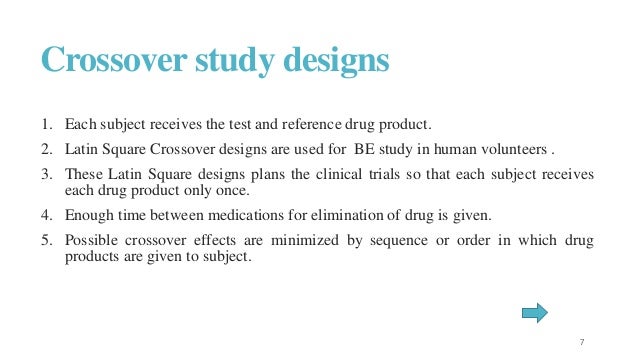
A bioequivalence study was carried out on two formulations of doxepin containing 15 of the active cis isomer and 85 of the less active trans isomerThe 90 confidence intervals In AUClast In Cmax and In CmaxAUClast for Ndesmethyldoxepin fell entirely within bioequivalence li whether stereoselective or non-stereoselective data were analyzed. In a parallel design each subject receives only one formulation in randomized fashion whereas in a crossover design each subject receives different formulations in different time periods. This guidance document is being distributed for comment purposes only. Bioequivalence may sometimes be demonstrated using an in-vitro bioequivalence standard especially when such an in-vitro test has been correlated with human in-vivo bioavailability data. In bioequivalence studies the study design also determines the appropriate statistical model for data analysis. Bioequivalence Study Design.

90 CI of mean TR. Based on pharmacokinetic PK data collected bioequivalence can then be assessed using valid statistical methods according to some pre-specified regulatory criteria for bioequivalence. 90 CI of mean TR. Thus in practice a standard two-sequence two-period or 2x2 crossover design is often applied. An overview of the generic drug approval process Division of Bioequivalence II Reviewer Kimberly W. Bioavailability And Bioequivalence Ppt Video Online Download.

Biometrical concepts of alternative designs and pooled analysis. Objective The basic design for bioequivalence study is determined by. 8000-12500 C max AUC 0-t and AUC 0-inf Narrow therapeutic index drug. Bioequivalence Studies With Pharmacokinetic Endpoints for Drugs Submitted Under an ANDA Guidance for Industry. This guidance document is being distributed for comment purposes only. Study Design For The Bioequivalence Evaluation Of Test And Reference Download Table.
In a simple parallel study design the statistical analysis should be conducted including the between-subject variability to calculate the 90 confidence interval of the treatment mean difference. Taking into account the pharmacokinetic properties of Molnupiravir the following guidance with regard to the study design should be taken into account. Based on pharmacokinetic PK data collected bioequivalence can then be assessed using valid statistical methods according to some pre-specified regulatory criteria for bioequivalence. An overview of the generic drug approval process Division of Bioequivalence II Reviewer Kimberly W. The availability of analytical methods 4. Be Bio Equivalence Study Design Basics 2 White Paper.
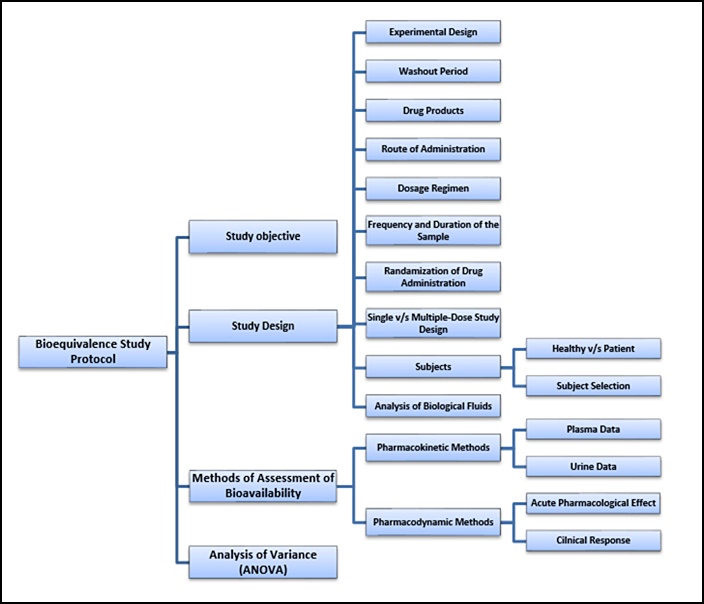
90 CI of mean TR. As recommended by the USFDA in most bioequivalence studies a test drug is compared with the standard reference drug in a group of normal healthy subjects of age 1855 years each receives both the treatments alternately in a crossover fashion two-period two-treatment crossover design with the two phases of treatment separated by a washout period. In bioequivalence studies the study design also determines the appropriate statistical model for data analysis. Taking into account the pharmacokinetic properties of Molnupiravir the following guidance with regard to the study design should be taken into account. Biometrical concepts of alternative designs and pooled analysis. Elements Of Bioequivalence Study Protocol.

90 CI of mean TR. 90 CI of mean TR. Denote the test product and the reference product by T and R respectively. In other situations bioequivalence may sometimes be demonstrated through comparative clinical trials or pharmacodynamic studies. A bioequivalence study compares the bioavailability between a test and a reference drug product in terms of the rate and extent of drug absorption. Bioavailability And Bioequivalence Study Designs Youtube.
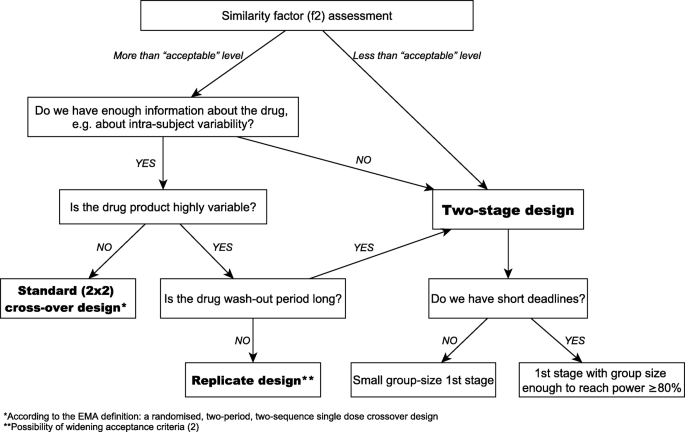
Bioequivalence - Study Design Considerations Study Design Considerations. Pk and Pd of drug substance 5. A single-dose cross-over design is recommended. Presents the recent developments in methodology including population and individual bioequivalence. Nature of reference material and dosage form to be tested 3. 10th Anniversary Of A Two Stage Design In Bioequivalence Why Has It Still Not Been Implemented Springerlink.
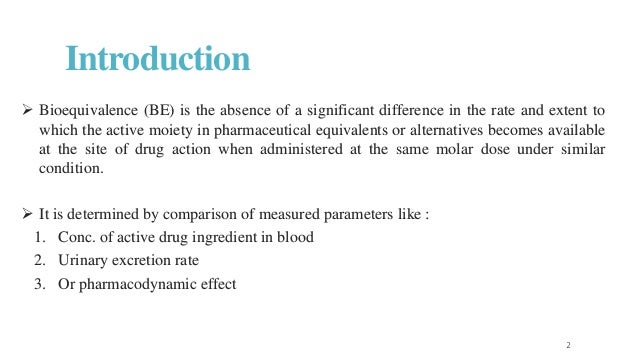
90 CI of mean TR. In a parallel design each subject receives only one formulation in randomized fashion whereas in a crossover design each subject receives different formulations in different time periods. Parallel design 56. The EoI includes 200 mg capsules. 41 Design conduct and evaluation of bioequivalence studies The number of studies and study design depend on the physico-chemical characteristics of the substance its pharmacokinetic properties and proportionality in composition and should be justified accordingly. Bioequivalence Study Design.

In bioequivalence studies the study design also determines the appropriate statistical model for data analysis. Bioequivalence may sometimes be demonstrated using an in-vitro bioequivalence standard especially when such an in-vitro test has been correlated with human in-vivo bioavailability data. In vivo comparative bioavailability studies. Biometrical concepts of alternative designs and pooled analysis. APIdays Paris 2019 - Innovation scale APIs as Digital Factories New Machi. Bioavilability And Bioequivalence Study Designs.

MAIN GUIDELINE TEXT 31 Design conduct and evaluation of bioequivalence studies The number of studies. Study design Randomized twosequence twoperiod crossover Treatment sequence is randomized Every subjects gets both treatments Half get generic drug first half get brand drug first minimizesthe sequence effect Crossover design Each subject serves as hisher own control minimizes intersubject variability. MAIN GUIDELINE TEXT 31 Design conduct and evaluation of bioequivalence studies The number of studies. Denote the test product and the reference product by T and R respectively. A single-dose cross-over design is recommended. Representation Of Parallel Study Design Download Scientific Diagram.
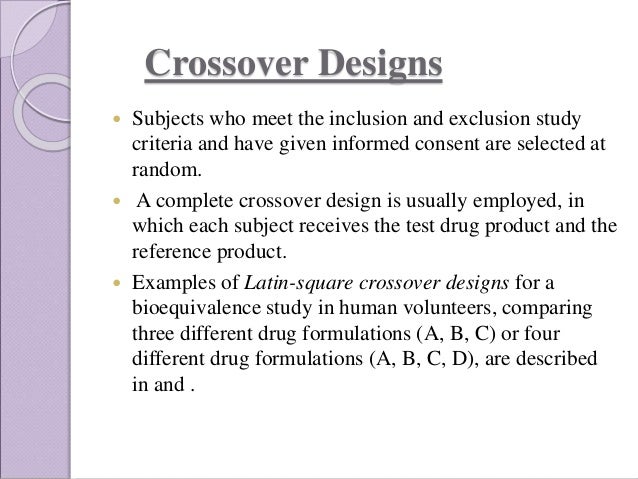
Taking into account the pharmacokinetic properties of Molnupiravir the following guidance with regard to the study design should be taken into account. Bioequivalence - Study Design Considerations Study Design Considerations. The test products used in the bioequivalence study must be prepared in accordance with GMP regulations. In vivo comparative bioavailability studies. The most common designs for bioequivalence studies are replicated crossover nonreplicated crossover and parallel. Bioavilability And Bioequivalence Study Designs.

The EoI includes 200 mg capsules. Provides a practical overview of the design and analysis of bioequivalence studies. Presents the recent developments in methodology including population and individual bioequivalence. Bioequivalence studies are often part of applications for generic veterinary medicinal products to allow bridging of safety and efficacy data associated with a reference veterinary medicinal product. Objective The basic design for bioequivalence study is determined by. Design Of The Four Bioequivalence Studies Download Scientific Diagram.

In other situations bioequivalence may sometimes be demonstrated through comparative clinical trials or pharmacodynamic studies. Bioequivalence may sometimes be demonstrated using an in-vitro bioequivalence standard especially when such an in-vitro test has been correlated with human in-vivo bioavailability data. As recommended by the USFDA in most bioequivalence studies a test drug is compared with the standard reference drug in a group of normal healthy subjects of age 1855 years each receives both the treatments alternately in a crossover fashion two-period two-treatment crossover design with the two phases of treatment separated by a washout period. A bioequivalence study is often conducted utilizing a crossover design that allows comparison within individual subjects ie each subject is at hisher own control. Biometrical concepts of alternative designs and pooled analysis. Bioequivalence Study Design.

In other situations bioequivalence may sometimes be demonstrated through comparative clinical trials or pharmacodynamic studies. Biometrical concepts of alternative designs and pooled analysis. In a parallel design each subject receives only one formulation in randomized fashion whereas in a crossover design each subject receives different formulations in different time periods. Provides a practical overview of the design and analysis of bioequivalence studies. Guidance for the design of bioequivalence studies. Best Bioequivalence Study Template Pekka Heikkila Ceo Statfinn Oy.

MAIN GUIDELINE TEXT 31 Design conduct and evaluation of bioequivalence studies The number of studies. Bioequivalence Studies With Pharmacokinetic Endpoints for Drugs Submitted Under an ANDA Guidance for Industry. Biometrical concepts of alternative designs and pooled analysis. 90 CI of mean TR. Parallel design 56. Ethical Guidelines And Study Design For Bioavailability And Bioequivalence Study Semantic Scholar.










